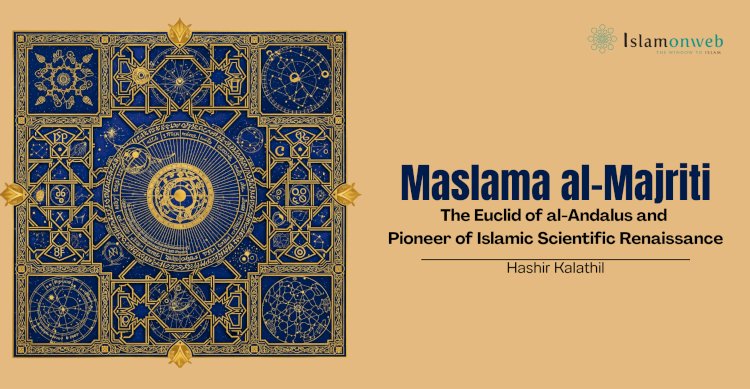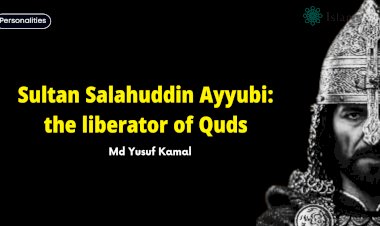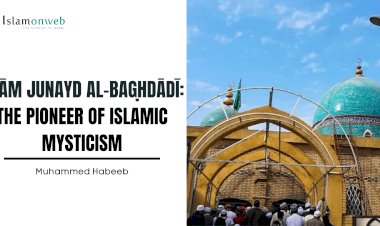Maslama al-Majriti: The Euclid of al-Andalus and Pioneer of Islamic Scientific Renaissance
Abū al-Qāsim Maslama ibn Aḥmad al-Majrīṭī (c. 950–1007, H. 338–398), also known as Maslama de Madrid, was a prominent Muslim scholar during the Golden Age of Islam in al-Andalus. He excelled in various fields, including astronomy, chemistry, mathematics, and economics. He thrived during the reigns of al-Ḥakam II and Hishām II, particularly within the intellectually rich environment of Córdoba, the capital of the Umayyad Caliphate.
Life and Education
Born in the mid-10th century in Madrid, al-Majrīṭī studied geometry and inheritance law under Ibn Faradī, and astronomy and arithmetic in Córdoba. As a young man, he settled in Córdoba and studied under the geometrician ʿAbd al-Ghafir ibn Muḥammad. He remained there until his death. Although he wrote on commercial arithmetic (muʿāmalāt) and was known as a popular astrologer, his most enduring contributions lie in the field of mathematical astronomy. Some historians, however, have misrepresented his association with works on magic and alchemy.
He was known as the Euclid of Spain and was regarded as one of the most esteemed scholars in the Caliphate of Córdoba. His Andalusian contemporaries recognised him as the leading astronomical authority of his time. Beyond his own compositions, al-Majrīṭī is notable in the history of Andalusian science for his role in teaching and scientific leadership. He founded the original school of Andalusian astronomers, where geometry and arithmetic were also cultivated.
Among his prominent disciples were Ibn al-Samḥ (d. 426/1035), Ibn al-Ṣaffār (d. 426/1034), al-Kirmānī (d. 458/1066), Ibn al-Jayyān (d. 447/1055–56), Ibn Jaldūn (d. 449/1057), Abū al-Ṣalt, al-Ṭurṭūshī, and Ibn Bargūth (d. 1052). These disciples, extending across three generations, had a lasting influence on the development and spread of the exact sciences in al-Andalus.
For the first time in al-Andalus, al-Majrīṭī unified two previously distinct mathematical traditions: that of mathematically based philosophical studies, which encompassed astronomy, and that of farā’iḍ (inheritance law). This synthesis reflected the interests of his two known teachers: ʿAlī ibn Muḥammad ibn Abī ʿĪsā al-Anṣārī, noted for his expertise in astronomy, and ʿAbd al-Ghafir ibn Muḥammad al-Farāḍī, who authored a work on farā’iḍ.
Contributions and Achievements
Al-Majrīṭī contributed to the Arabic version of Ptolemy’s Planisphaerium. He was the first Andalusian scholar known to have carried out his own astronomical observations. Some earlier historians mistakenly assumed that he had learned Greek and translated the Planisphaerium himself. More recent research, however, shows that he most likely revised and improved upon an existing Eastern Arabic translation of the work.
Al-Majrīṭī’s revision introduced significant scientific advancements. He refined methods for determining the fundamental lines of the astrolabe[[1]] and for locating fixed stars on its star map by applying different coordinate systems.
He also authored an important work, A Treatise on the Astrolabe[2], composed while studying its manufacture and use. This treatise is preserved in the library of the Royal Monastery of San Lorenzo de El Escorial, catalogued as number 967 of the Arabic Collection. In it, he accurately calculated the ascensions of the zodiac signs and the declinations of stars. In the second part of this work, al-Majrīṭī addressed several problems in spherical astronomy, applying the Menelaus theorem[[3]].
He was the first astronomer in al-Andalus to determine the longitude of the star Regulus (135°40′), a significant contribution to the discipline of astronomy.
Al-Majrīṭī’s works in mathematical astrology, and the ḥājib al-Manṣūr’s reliance on court astrologers for both military and personal purposes, stand in contrast to the burning of astrological works during the reign of al-Ḥakam II (961–976). Maslama himself is reported to have drawn a horoscope for the conjunction of Saturn and Jupiter in 397/1006–7, at the time of a change in triplicity, in which his prognosis was a change of dynasty, destruction, massacres, and famine.
Maslama carried out all his professional activities in Córdoba, where he established a school of mathematicians and astronomers. The genealogy of this intellectual tradition can be reconstructed from the data provided by Ṣāʿid al-Andalusī in his Ṭabaqāt al-Umam (“Categories of Nations”). However, it is impossible to establish a clear chronology of al-Majrīṭī’s works, as most of their titles remain unknown. Ṣāʿid, in his Ṭabaqāt al-Umam, notes that al-Majrīṭī had deeper knowledge of ʿilm al-aflāk (astronomy) and ḥarakāt al-nujūm (motions of the stars) than the scholars who preceded him. This indicates—though the evidence is limited—that Maslama’s interests extended beyond the calculation of planetary positions to broader questions of cosmology [[4]].
It appears that Maslama al-Majrīṭī updated the chronological tables by inserting the intercalary day at the end of December in leap years. He also introduced significant modifications to the mean motion tables, employing the Persian calendar and the era of Yazdegerd III[[5]], whereas the preserved tables rely on the Muslim lunar calendar and the Hijra as the epoch. For example, Maslama seems to have added a set of astrological tables that allowed the division of horoscope houses using the so-called “standard method.”
Ṣāʿid al-Andalusī described him as the greatest astronomer and philosopher of al-Andalus in his time. Working closely with his colleague Ibn al-Ṣaffār, he also developed new methods of land surveying. He wrote a book on taxation and the Andalusian economy, and he is also reported to have served as the astrological advisor to al-Manṣūr[[6]], guiding him on favourable times to launch his military campaigns. It is even said that he foretold the downfall of the Caliphate and described how it would unfold, long before those events occurred.
Several important works attributed to al-Majrīṭī
- Rutbat al-Ḥakīm (“The Rank of the Sage”): Composed after the year 1009, this work is alchemical in focus. It provides formulas and instructions for refining precious metals and outlines the preparation of mercuric oxide on a quantitative basis.
- Ghāyat al-Ḥakīm (“The Aim of the Wise”): Translated into Spanish under the royal patronage of Alfonso el Sabio, it later achieved wide circulation throughout Europe under its Latin title Picatrix. This scholarly compendium synthesises magical theory, cosmological doctrine, and astrological methodology, constituting the most comprehensive surviving record of popular mystical beliefs characteristic of 11th-century Islamic intellectual culture.
The Rutbat al-Ḥakīm and the Ghāyat al-Ḥakīm are two significant Andalusian works in the field of the occult sciences. The first is an alchemical treatise, arguably the earliest systematic work of its kind produced in the Iberian Peninsula. The second deals with magical practices, with particular emphasis on astral magic. Contemporary scholarship attributes both treatises to the bāṭinī traditionalist Maslama al-Majrīṭī.
These two parallel works, each structured with a prologue and four books, were intended as the culminating stages of a philosophical progression. Maslama referred to them as “the two conclusions (of philosophy),” consistently emphasising that scholarly attainment remained fundamentally incomplete without mastery of these complementary esoteric disciplines. He argued that “the sage” would otherwise remain deficient and imperfect in intellectual growth.
Ibn Khaldūn (d. 808/1406), the renowned historian, philosopher, and sociologist, accorded considerable significance to these treatises, though often maintaining a critical view of esoteric studies. In agreement with several modern scholars, he ascribed their authorship to Maslama al-Majrīṭī. In his Muqaddimah, Ibn Khaldūn portrayed Maslama as the foremost Andalusian mathematician, regarding the Ghāyat al-Ḥakīm as the most authoritative and comprehensive Arabic treatise on magic, while also holding the Rutbat al-Ḥakīm in high esteem as its alchemical counterpart.
About the author
Hashir Kalathil, currently pursuing his third year of degree studies at Sabeelul Hidaya Islamic College, Prappur
References
Casulleras, Josep. n.d. https://islamsci.mcgill.ca/RASI/BEA/Majriti_BEA.htm.
n.d. parabook. https://prabook.com/web/maslama.al-majriti/3757368.
Samso, Julio. n.d. Maslama al-Mayriti | Royal Academy of History. https://dbe.rah.es/biografias/7778/maslama-al-mayriti.
Suárez, Irene. 2019. FUNCI. June 21. https://funci.org/maslama-al-mayriti-maslama-of-madrid/.
—. 2019. Maslama al-Mayriti, Maslama el Madrileno. 06 21. https://funci.org/maslama-al-mayriti-maslama-el-madrileno/.
Vernet, Juan. 2023. Al-Majrīt Complete Dictionary of Scientific Biography. . December 12. https://www.encyclopedia.com/science/dictionaries-thesauruses-pictures-and-press-releases/al-majrit.
Wikipedia. 2023. Maslama al-Majriti - Wikipedia. november 1. https://en.wikipedia.org/wiki/Maslama_al-Majriti
Citations
[1] The astrolabe is an ancient astronomical instrument used for measuring the position and height of the stars above the sky.
[2] A two-part treatise consisting of 130 chapters.
[3] A unique trigonometric instrument was used in his time.
[4] a branch of knowledge that studies the physical structure of spheres
[5] last king of the Sassanian Empire
[6] Almanzor (938 - 1002) was a Muslim Arab Andalusi military leader and statesman. He was the
chancellor of the Umayyad Caliphate of Córdoba and the hajib (chamberlain) for the weak Caliph Hisham II.
Disclaimer
The views expressed in this article are the author’s own and do not necessarily mirror Islamonweb’s editorial stance.
























Leave A Comment